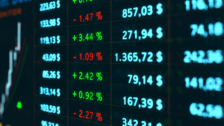6 benchmark busters; AU vs. US
It has been one volatile year to say the least. Both the Australian and US stock markets traded in volatile conditions with many asset classes – and more importantly, sectors – delivering poor returns. From rising geopolitical trade tensions between the USA and China to an unprecedented pandemic that spread over multiple countries and brought the global economy to its knees, investors were dealt an unpredictable hand.
The S&P/ASX 200 Index closed the financial year down -10.91%, making it the worst performance since 2011-12. Much of the year’s losses were due to the Coronavirus outbreak and the subsequent selldown and shutdown of global economies.
The best performing stocks of the S&P/ASX 200 came primarily from the tech and healthcare sectors – no surprises there! Market darling Afterpay Ltd (ASX: APT) continued its mammoth run, closing the year up +143.3% on the back of its US expansion and Tencent stake. In second place was West Africa-focused gold miner Perseus Mining Ltd (ASX:PRU), which closed +123.90% rising on the back of the gold price as margins and production grow.
In third and fourth place were dual-listed Kiwi company Fisher & Paykel Healthcare Ltd (FPH) and biotech Mesoblast (MSB), which closed the financial year up 121.40% and up 120.30% respectively, both rising off the back of the COVID-19 crisis. In fifth place was tech stock Megaport Limited (MP1) which closed the year +120.30, benefiting from a ramp-up in bandwidth requirements, while in fifth place came Domino’s Pizza (DMP), which closed the year up 82.50% after taking advantage of the Coronavirus lockdown.
| Company (Ticker) | Price Change |
| AfterPay (APT) | 143.30% |
| Perseus Mining (PRU) | 123.90% |
| Fisher & Paykel H (FPH) | 121.40% |
| Mesoblast (MSB) | 200.00% |
| Megaport Limited (MP1) | 120.30% |
| Domino Pizza Enterprise (DMP) | 82.50% |
The Dow Jones Index closed the financial year +7.00%, outpacing the Australian market, while the broader S&P 500 finished with an 11% gain, driven by the unprecedented level of central bank intervention. It was a similar story with tech and healthcare stocks proving the best place to hide during the COVID-19 turmoil. Fastly (NASDAQ:FSLY) was the best performing tech stock rallying 324%. The company looks after content delivery, helping ecommerce websites reach their audiences more efficiently.
Zoom Video Communications (NYSE:ZM) closed the year +273% after Coronavirus isolation policies caused increasing reliance on videoconferencing technology. In third place was online sports betting stock DraftKings (NASDAQ:DKNG) which closed +211%. In fourth place was Livongo Health (NASDAQ: LVGO), which closed up 200%. The cloud-based provider of chronic disease management was also a beneficiary of the coronavirus pandemic. And finishing off the list were home-made goods retailer Etsy (NASDAQ:ETSY), up +140%, and Shopify (NYSE:SHOP), up 139%. Both stocks attracted retail customers unable to shop in physical stores during the pandemic.
Here are the year’s best performing US tech stocks with a market value of at least US$5 billion.
|
|||||||||||||||
| While both the tech and healthcare sectors stood to benefit from the pandemic, it’s hard to compare Afterpay, which is an $18bn Aussie tech company, with the likes of say Shopify (SHOP), which is a mammoth $120bn Canadian tech company that is exposed to a far larger market than in Australia. The New York Stock Exchange and the NASDAQ are the two largest stock exchanges in the world in terms of market capitalisation, and also offer some of the most lucrative opportunities. Most of the largest companies such as Facebook, Amazon, Alphabet, Netflix and Google (FAANG) are listed in the US. |










